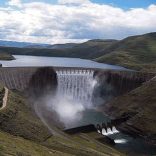Gemfields confirms G-Factor for Mozambique's Montepuez ruby mine and Zambia's Kagem emerald mine
Mozambique: HCB records production of 8,013.6 GWh over the last six months

File photo: HCB
Hidroeléctrica de Cahora Bassa (HCB), the company that operates the Cahora Bassa dam on the Zambezi River, in the western Mozambican province of Tete, in the first six months of this year, achieved production of 8,013.6 gigawatt-hours (GWh), a figure that exceeds the half-year production plan by 14.8 per cent and is an increase of 0.6 per cent compared to the same period in 2022.
According to note from the company, “at the same time, HCB has put in its portfolio the prospect of realising short and medium-term energy production projects through alternative sources, with emphasis on the construction of a photovoltaic plant of up to 400 megawatts, with the possibility of evolving in the future.”
In the long term, the statement adds, “the company is conducting strategic reflections with a view to reactivating the Cahora Bassa Norte [hydroelectric power station] project, to meet the growing energy demand in Mozambique and the region, in the face of the ongoing crisis.”
(This refers to plans for a second power station at the dam, on the north bank of the river. Had the South African electricity company Eskom been willing to sign an agreement to purchase the power, the station would have been built decades ago).
READ: Mozambique: Plan revived to build second Cahora Bassa hydroelectric plant
With regard to available water resources, the company ended the first half of 2023 with storage at 92.5 per cent of its useful volume, corresponding to the water surface level in the reservoir of 324.5 metres above the average sea level, and “this seems satisfactory to guarantee the budgeted production by the end of the year, estimated at 14,291.6 GWh.”













Leave a Reply
Be the First to Comment!
You must be logged in to post a comment.
You must be logged in to post a comment.